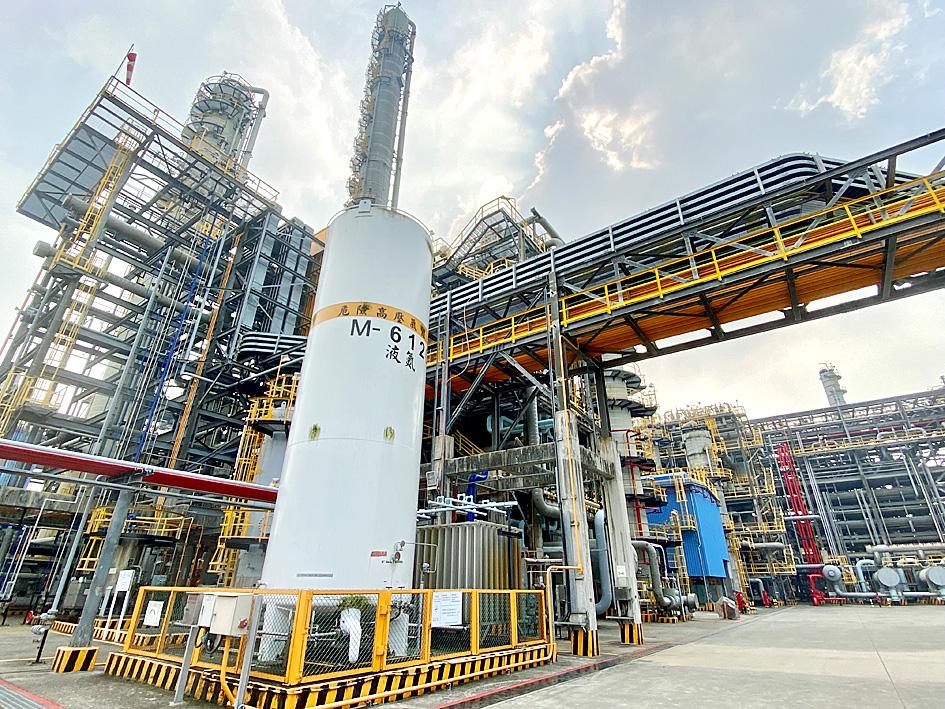The industrial production index rose 7.33 percent year-on-year to 132.7 last month, marking the best April performance, thanks to strong demand for chips used in high-performance computing (HPC) devices, vehicles and Internet-of-Things (IoT) devices, the Ministry of Economic Affairs said yesterday.
Manufacturing, a major contributor to industrial production, jumped 7.5 percent annually to 135.19, landing on the higher end of the ministry’s forecast of 5 to 8.2 percent annual growth.
China’s COVID-19 lockdowns did not have a significant impact on local production, but did affect supply of some components, the ministry said.

Photo: Hung Chen-hung, Taipei Times
Some manufacturers, such as server makers, received rush orders last month, as production in China was disrupted, it said.
“Wider adoption of emerging technologies continued to drive up semiconductor demand in April, and semiconductor companies are expanding capacity to cope with the high demand,” Department of Statistics Deputy Director-General Huang Wei-jie (黃偉傑) said by telephone.
“Rising demand for HPC devices such as servers continued boosting demand for the electronic component segment,” Huang said. “The growth was partly moderated by sagging demand for consumer electronics, such as mobile phones in China.”
The ministry expects the uptrend to extend into this month and forecast robust manufacturing production expansion of between 5.2 percent and 8.3 percent year-on-year to between 137.55 and 144.55, supported mainly by electronic components, computers and other electronics segments.
Electronic component production climbed 17.81 percent annually last month, led by the semiconductor sub-index’s 27.65 percent year-on-year expansion. Display and related products tumbled 14.6 percent year-on-year, ending 24 months of growth.
The production of computers and other electronics grew at an annual pace of 5.48 percent last month, benefiting from robust demand for cloud-enabled servers and relaxed component shortages that helped boost output of computers, routers and network switches.
The petrochemicals sector saw production drop 5.18 percent year-on-year, mainly due to reduced demand for products to counter COVID-19 infections and some clients in China halting production due to lockdowns.
China absorbs about 40 percent of Taiwanese petrochemical exports.
The machinery sector saw production contract 0.97 percent annually, snapping 19 straight months of growth.
The ministry attributed the decline to Chinese customers’ concerns about placing new orders and investments.
Surging raw material costs and transportation costs also affected customers’ willingness to purchase, it said. About 30 percent of machinery tools made in Taiwan are shipped to China.
The production of basic metals dipped 7.12 percent year-on-year last month, as major steelmakers suspended production due to annual maintenance and reduced demand from China.
The production of vehicle and auto components dipped 1.26 percent as chip shortages and stricter requirements for applying for commodity tax refunds depressed demand for new vehicles, Huang said.
“Local auto manufacturers source a lot of their components from China. They said the lockdowns have shut factories and made it even more difficult to secure component supply,” he said.

Nvidia Corp’s demand for advanced packaging from Taiwan Semiconductor Manufacturing Co (TSMC, 台積電) remains strong though the kind of technology it needs is changing, Nvidia CEO Jensen Huang (黃仁勳) said yesterday, after he was asked whether the company was cutting orders. Nvidia’s most advanced artificial intelligence (AI) chip, Blackwell, consists of multiple chips glued together using a complex chip-on-wafer-on-substrate (CoWoS) advanced packaging technology offered by TSMC, Nvidia’s main contract chipmaker. “As we move into Blackwell, we will use largely CoWoS-L. Of course, we’re still manufacturing Hopper, and Hopper will use CowoS-S. We will also transition the CoWoS-S capacity to CoWos-L,” Huang said

Nvidia Corp CEO Jensen Huang (黃仁勳) is expected to miss the inauguration of US president-elect Donald Trump on Monday, bucking a trend among high-profile US technology leaders. Huang is visiting East Asia this week, as he typically does around the time of the Lunar New Year, a person familiar with the situation said. He has never previously attended a US presidential inauguration, said the person, who asked not to be identified, because the plans have not been announced. That makes Nvidia an exception among the most valuable technology companies, most of which are sending cofounders or CEOs to the event. That includes

INDUSTRY LEADER: TSMC aims to continue outperforming the industry’s growth and makes 2025 another strong growth year, chairman and CEO C.C. Wei says Taiwan Semiconductor Manufacturing Co (TSMC, 台積電), a major chip supplier to Nvidia Corp and Apple Inc, yesterday said it aims to grow revenue by about 25 percent this year, driven by robust demand for artificial intelligence (AI) chips. That means TSMC would continue to outpace the foundry industry’s 10 percent annual growth this year based on the chipmaker’s estimate. The chipmaker expects revenue from AI-related chips to double this year, extending a three-fold increase last year. The growth would quicken over the next five years at a compound annual growth rate of 45 percent, fueled by strong demand for the high-performance computing

TARIFF TRADE-OFF: Machinery exports to China dropped after Beijing ended its tariff reductions in June, while potential new tariffs fueled ‘front-loaded’ orders to the US The nation’s machinery exports to the US amounted to US$7.19 billion last year, surpassing the US$6.86 billion to China to become the largest export destination for the local machinery industry, the Taiwan Association of Machinery Industry (TAMI, 台灣機械公會) said in a report on Jan. 10. It came as some manufacturers brought forward or “front-loaded” US-bound shipments as required by customers ahead of potential tariffs imposed by the new US administration, the association said. During his campaign, US president-elect Donald Trump threatened tariffs of as high as 60 percent on Chinese goods and 10 percent to 20 percent on imports from other countries.